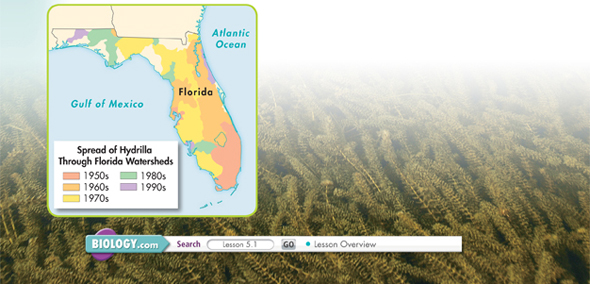5.1 How Populations Grow
 How do ecologists study populations?
How do ecologists study populations? What factors affect population growth?
What factors affect population growth? What happens during exponential growth?
What happens during exponential growth? What is logistic growth?
What is logistic growth?
population density • age structure • immigration • emigration • exponential growth • logistic growth • carrying capacity
Concept Map As you read, use the highlighted vocabulary words to create a concept map that organizes the information in this lesson.
THINK ABOUT IT In the 1950s, a fish farmer in Florida tossed a few plants called hydrilla into a canal. Hydrilla was imported from Asia for use in home aquariums because it is hardy and adaptable. The fish farmer assumed that hydrilla was harmless. But the few plants he tossed away reproduced quickly… and kept on reproducing. Today, their offspring strangle waterways across Florida and many other states. Tangled stems snag boats in rivers and overtake habitats; native water plants and animals are disappearing. Why did these plants get so out of control? Is there any way to get rid of them?
Meanwhile, people in New England who fish for a living face a different problem. Despite hard work and new equipment, their catch has dropped dramatically. The cod catch in one recent year was 3048 metric tons. Back in 1982, it was 57,200 metric tons—almost 19 times higher! Where did all the fish go? Can anything be done to increase their numbers?
Describing Populations
 How do ecologists study populations?
How do ecologists study populations?
At first glance, the stories of hydrilla and cod may seem unrelated. One is about plants growing out of control, and the other is about fish disappearing. Yet both involve dramatic changes in the size of a population. Recall that a population is a group of organisms of a single species that lives in a given area.  Researchers study populations' geographic range, density and distribution, growth rate, and age structure.
Researchers study populations' geographic range, density and distribution, growth rate, and age structure.

FIGURE 5–1 Invasive Hydrilla Hydrilla has spread through most of Florida in just a few decades. Efforts to control the waterweed cost millions of dollars a year.
Table of Contents
- Formulas and Equations
- Applying Formulas and Equations
- Mean, Median, and Mode
- Estimation
- Using Measurements in Calculations
- Effects of Measurement Errors
- Accuracy
- Precision
- Comparing Accuracy and Precision
- Significant Figures
- Calculating With Significant Figures
- Scientific Notation
- Calculating With Scientific Notation
- Dimensional Analysis
- Applying Dimensional Analysis




